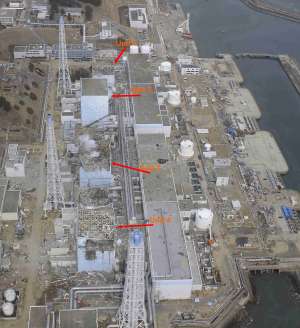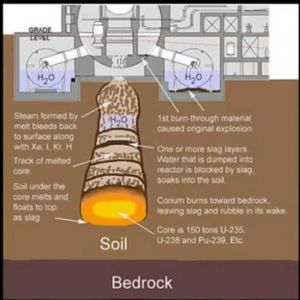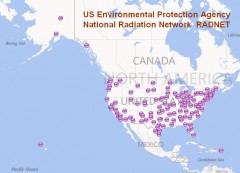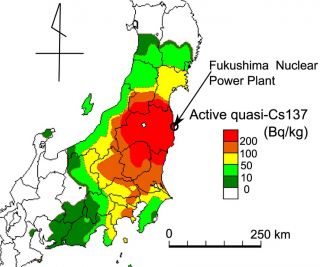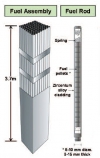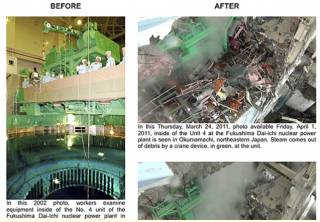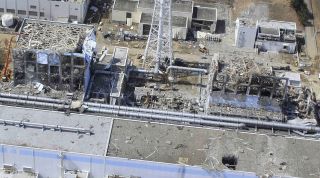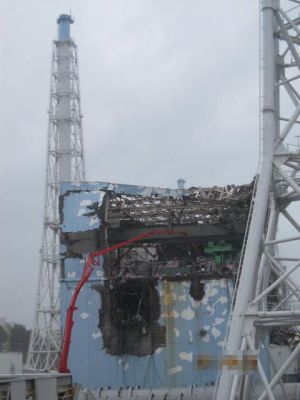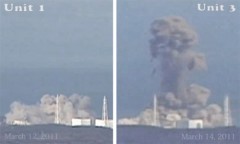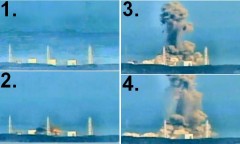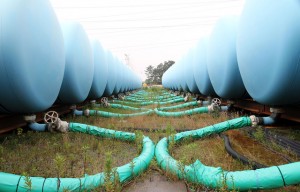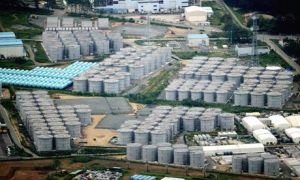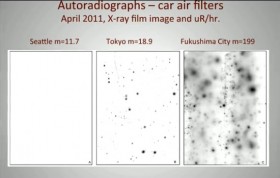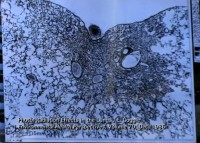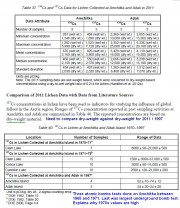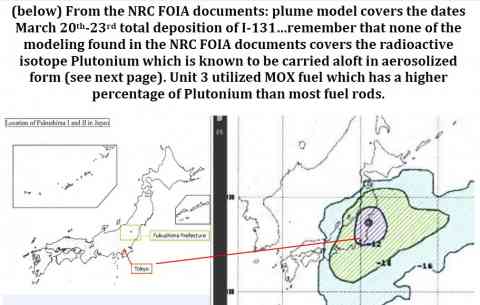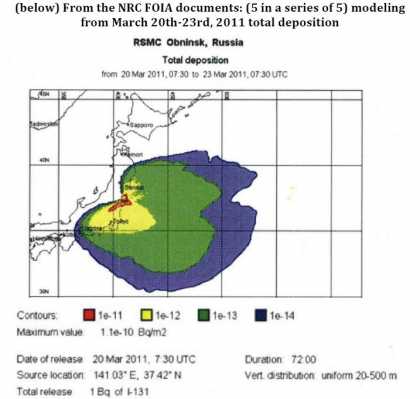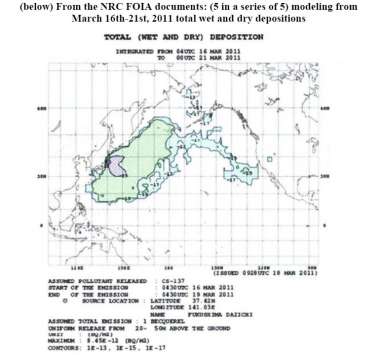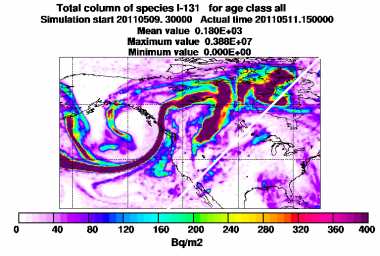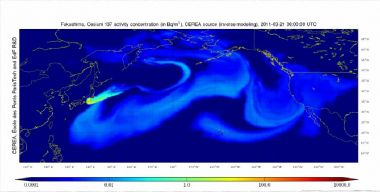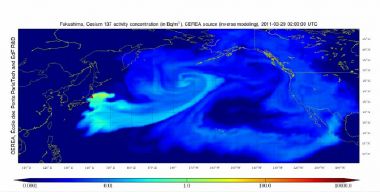The Three Fukushima Nuclear Reactor Core Meltdowns and Widespread Contamination
 international |
environment |
feature
international |
environment |
feature  Wednesday March 19, 2014 21:53
Wednesday March 19, 2014 21:53 by T
by T
It was three years on March 11th since the triple nuclear meltdown at the Fukushima plant in Japan in 2011. This article attempts to try and give an picture of the situation today and to show that the accident is still an active event that will take many decades to cleanup and it is anything but over.
Remembering What Happened
It is three years since the accident on March 11th 2011 at the Fukushima power station complex. There has been surprisingly little coverage of it in the mainstream media compared to the Chernobyl accident in 1986 at the time. As most people know, the accident was a result of an earthquake which caused the tsunami which flooded the Fukushima site and knocked out the backup diesel generators used for cooling the plants and that is how the story goes. The first report many people heard was that they were using sea-water to cool the reactors. This in itself was frightening because sea-water and cooling of nuclear reactors should not be in the same sentence, ever and it can only mean one thing -the situation is desperate, everything has failed and since sea-water would destroy the reactor vessel and fuel rods it means its the very last resort at trying to stop a meltdown.
Related Links:
The explosive truth behind Fukushima's meltdown |
Fukushima Investigation: “Within one day complete meltdown and melt through occurred” — “There is no way that gov’t did not know this” (VIDEO) |
Worse than Chernobyl: The inner threat of Fukushima crisis |
Fukushima Diary |
FukushimaOnTheGlobe.com |
SafeCast.org -radiation maps |
Hatrick Penry - Plume Gate |
Fukushima Emergency what can we do? |
Fukushima meltdown appears to have sickened American infants |
Unexpected Mortality Increase in United States Follows Arrival of the Radioactive Plume From Fukushima. Is There A Correlation? |
Canada and U.S. cut back radiation reporting |
The Truth About Radiation and the Fukushima Meltdowns |
Cryptome Photos Series of Fukushima |
There is no way to stop Fukushima radioactive water leaking into the Pacific |
ENE News on Japan Nuclear Accident |
Toxic Tokyo Cesium Air Danger - Japan Burn Radioactive Debris - Arnie Gundersen Interview. Oct 2011 |
Plume models from ASR Ltd of radiactive cloud from Fukushima |
Global Atmospheric dispersion of radionuclides from the Fukushima-Daichii nuclear power plant |
National Diet of Japan Fukushima Nuclear Accident Independent Investigation Commission |
Health and Related |
Fukushima Daiichi Nuclear Power Station Catastrophe in Japan following 11 March 2011 Magnitude 9.0 Earthquake - the Largest in Japan's History |
Chernobyl: Understanding Some of the True Costs of Nuclear Technology |
Fukushima Residents Seek Answers Amid Mixed Signals From Media, TEPCO and Government. Report from the Radiation Exclusion Zone |
The US Navy knew: Fukushima's 'hard rain' on USS Ronald Reagan |
90Sr and 89Sr in seawater off Japan as a consequence of the Fukushima Dai-ichi nuclear accident |
Fukushima kids have skyrocketing number of thyroid abnormalities - report |
The Implications of The Massive Contamination of Japan With Radioactive Cesium |
NRC FOI Documents |
Fish with radiation over 2,500 times safe levels found near Fukushima plant | Jan 2013
Hot Particles and Measurement of Radioactivity -Arnie Gundersen |
Radiation risks from Fukushima 'no longer negligible' |
Plume models from CEREA, France |
Beyond Fukishima: A World in Denial About Nuclear Risks by Danny Schechter
The Fukushima Daiichi Complex
At the now devastated Fukushima Daiichi site, there are four nuclear reactors on the main site and another two a bit further away. When the earthquake struck, reactors #4, #5 and #6 were offline for maintenance while three reactors #1, #2, and #3, were running and these automatically shutdown. However in the case of a nuclear power plant, the nuclear fuel rods still produce tremendous amounts of heat which cannot be turned off. This heat arising from radioactive decay, amounts in the immediate aftermath of shutdown to about 5% of the full power. The rated power output for reactors #1 and #2 was 439 Megawatts (MW) and 784 MW for #3. That means 5% of 439 MW is 21 MW whilst of 739 MW it is 36 MW. That's a lot of heat to get rid of and if you don't then the water which the fuel rods are immersed in, will quickly boil off and after that the fuel rods will start to buckle and melt and react with steam to give off hydrogen gas and at that point, you then have the certainty of a hydrogen explosion followed by a core meltdown as the rods fall to the floor. The huge heat being emitted by the tons of highly radioactive fuel rods would cause the bottom of reactor steel vessel to melt allowing the molten pile of nuclear debris to drop down onto the concentre floor under the vessel and then slowly melt through the concrete down into the ground taking days and weeks. The radiation would be intense and deadly and fission reactions would continue for quite awhile, adding to the deadly cocktail of radionuclides given off into the surrounding environment.
In addition to the reactors themselves each of the plants have their own spent fuel pools for storing the nuclear waste. These are huge concrete pools filled with tonnes of water to a depth of 30 metres or more and when the nuclear fuel rods are removed from the reactor, they have to be stored in them for years. At Fukushima, Units 1 to 4 had about 1,000 fuel assemblies in their spent fuel pools each while units 5 & 6 had closer to 1,500 each. And each fuel assemble contains multiple fuel rods. And as if all this wasn't bad enough, reactor #3 was burning a mixture of Uranium and Plutonium, (MOX).
The Breaking News in March 2011
It is from this point on where things get hazy because TEPCO the company that operates the nuclear plants gave conflicting statements that they were trying to cool the reactors with sea-water, water jets, and long spray hoses, that fuel rods had been exposed and reports of various radiation leaks and so forth. In other words they seemed to be telling us quite a lot but it was confusing too. News reports at the time indicated once the backup diesel pumps had been flooded, they were down to relying on battery power and these were designed to only work for 8 hours. There was also reports that external power to the site had been lost and because of earthquake damage in the area, there was little chance of getting it reconnected soon or at least not until well after the batteries were exhausted. But in all this TEPCO would not admit in the days and few weeks that followed that they had three core meltdowns within approximately 4 days of the batteries going dead. A government spokesman Yukio Edano insisted: "There has been no meltdown... It was an unforeseeable disaster.." It turns out reactor #1 had a core meltdown within 16 hours, reactor #3 within 44 hours and reactor #2 after approximately 100 hours or 4 days. The reason for the delay in reactor #2 melting down is because they managed to keep enough coolant to it until the evening of the 3rd day (Mar 14th 18:00) and similar for reactor #2 because it only takes 5 to 8 hours for the tonnes of water to boil off. Earlier in the day at approximately 13:15 reactor core isolation cooling system for reactor 2 stopped and this could have been due to damage sustained in the explosion 2 hours previously at Unit 3.Box 1: The Role of the International Atomic Energy Agency and Relationship to World Health Organisation (WHO)
The International Atomic Energy Agency (IAEA) UN agency were setup in 1957 to promote nuclear power and partially counteract the negative image of all things nuclear as a result of the use of the atomic bomb. They have considerable power since they were born out of the highest levels within governments and powerful sections of the military and indeed of the nuclear industry itself. It is safe to say it is a highly politicized institution. Organizations like this tend to be stocked with people suffering from blind faith in all things nuclear and who go into complete denial about any problems caused by it, for this challenges the very core of their beliefs and life long work.Before we go any further the relationship between the IAEA and WHO needs to be clarified as this will explain certain things such as why the WHO claimed only 43 deaths were attributable to Chernobyl whereas a recent New York Academy of Sciences book on it, puts the figure at 980,000 and at least 125,000 of these were the 'liquidators' drafted in by the USSR to clean up the reactor and seal it. The book's findings are reported here and here. The book's title is: Chernobyl: Consequences of the Catastrophe for People and the Environment and copyright has been released and it is available in PDF here.
"In the early days of nuclear power, WHO issued forthright statements on radiation risks such as its 1956 warning: Genetic heritage is the most precious property for human beings. It determines the lives of our progeny, health and harmonious development of future generations. As experts, we affirm that the health of future generations is threatened by increasing development of the atomic industry and sources of radiation … We also believe that new mutations that occur in humans are harmful to them and their offspring.But there still are genuine people working/researching for WHO who try to be honest and do things with an open mind. It is just when research funding or authorization happens or reports released, they have to pass through people who are in charge and this is where the interagency gatekeeping, filtering, censoring and control is applied. And in 1995 the then WHO Director Hiroshi Nakajima held a conference of 700 experts and physicians who would go on to produce the most comprehensive report of the human consequences of the Chernobyl meltdown to date. This report was never published, never released to the public, and erased from history by orders of the IAEA. This came to the public's attention later when a small Swiss news documentary entitled 'Nuclear Controversies' was aired.After 1959, WHO made no more statements on health and radioactivity. What happened? On 28 May 1959, at the 12th World Health Assembly, WHO drew up an agreement with the International Atomic Energy Agency (IAEA); clause 12.40 of this agreement says: Whenever either organisation [the WHO or the IAEA] proposes to initiate a programme or activity on a subject in which the other organisation has or may have a substantial interest, the first party shall consult the other with a view to adjusting the matter by mutual agreement." In other words, the WHO grants the right of prior approval over any research it might undertake or report on to the IAEA – a group that many people, including journalists, think is a neutral watchdog, but which is, in fact, an advocate for the nuclear power industry. The IAEA's founding papers state: "The agency shall seek to accelerate and enlarge the contribution of atomic energy to peace, health and prosperity through the world." [from source]
Reconstructing What Happened
It is evident now that in the immediate hours after the earthquake and tsunami that the first reaction of TEPCO, Japanese government and other authorities and agencies supportive of nuclear power like the IAEA (see box 1 for more about IAEA), was to try and play down what was happening and to allow enough information out so as to appear to give the full information, but to actually hold back the full extent of what was happening so that the full implications were not known because it really was the worst case scenario. There were many reasons for this strategy besides the basic one of looking after the industry's interests and that was because Chernobyl had already dealt a blow to the nuclear industry and it had taken years of PR spin to recreate a positive image. But it takes a few hours when a crisis hits, for the multitude of government and intergovernmental agencies to sync up and co-ordinate the flow of information and thence to speak with just one consistent voice. This is essential otherwise you could end up having officials releasing information that contradicts the message they want to put out and the 'wrong' information could get out. A good example of this was the US State Dept, initially announced that it's citizens should evacuate but then pulled back from that statement. After that we heard little more from them even though most people were expecting some kind of news about radioactive plumes since this was the main story during Chernobyl and people in general acknowledge the expertise of the US on all things nuclear and so were expecting a more independent view that they might expect from the Japanese. But there was almost nothing and no mention at all of plumes being detected anywhere further afield, except 'safely' out to sea. This was despite the fact that all their (US) naval ships and military bases (in Japan & Guam) have extensive radiation detection and monitoring equipment as part of their nuclear weapons capability and infrastructure. In addition the military have an extensive land based network in the USA itself and every nuclear power plant has radiation detectors on site and the EPA have RADNET which covers US territory. Likewise every European country has radiation detectors and certainly those with nuclear power would also have numerous detection sites. Again we heard almost nothing about any fallout detected anything other than bland reassurances that anything measured was too low to worry about although in France apparently there was brief warnings for a few days to wash fresh fruit. More on this later.Meanwhile our neighbours, Britain quickly dispatched teams to help out but it seems the only helping was to help control the flow of information and to carefully manage the information such that no panic ensured whilst the meltdowns were in progress. The US too had a team from the Nuclear Regulatory Authority (NRC) in Japan to help monitor and assess the situation for their own government and to give advice and any help to the Japanese. Luckily they were there because it was later through Freedom of Information requests to the NRC that certain information came out. As is almost standard procedure in environmental disasters, TEPCO stood up to the plate and claimed the accident was an unforeseen disaster. This of course was was a complete lie because a subsequent investigation by the Japanese government showed that a decade before they were warned that the sea-wall was not high enough to block a tsunami like the one that hit and instead TEPCO successfully spent millions lobbying the government to NOT build the wall higher. In the official investigation which interviewed over hundreds of workers and officials, a clear picture emerges of significant damage to the Fukushima site including buildings and crucially to the cooling pipes to the reactors by the earthquake. So even without the tsunami multiple meltdowns were inevitable. A report in Aug 2011 in the UK independent details and explains the significance of this. They quote two workers who were on the site at the time of the earthquake.
Worker A said: "I personally saw pipes that had come apart and I assume that there were many more that had been broken throughout the plant. There's no doubt that the earthquake did a lot of damage inside the plant... I also saw that part of the wall of the turbine building for reactor one had come away. That crack might have affected the reactor." and worker B added: "It felt like the earthquake hit in two waves, the first impact was so intense you could see the building shaking, the pipes buckling, and within minutes I saw pipes bursting. Some fell off the wall... I could see that several pipes had cracked open, including what I believe were cold water supply pipes. That would mean that coolant couldn't get to the reactor core. If you can't sufficiently get the coolant to the core, it melts down. You don't have to have to be a nuclear scientist to figure that out."Mitsuhiko Tanaka, a former nuclear plant designer, describes what occurred on 11th March 2011 as a loss-of-coolant accident. "The data that Tepco has made public shows a huge loss of coolant within the first few hours of the earthquake. It can't be accounted for by the loss of electrical power. There was already so much damage to the cooling system that a meltdown was inevitable long before the tsunami came." He says the released data shows that at 2.52pm, just after the quake, the emergency circulation equipment of both the A and B systems automatically started up. "This only happens when there is a loss of coolant." Between 3.04 and 3.11pm, the water sprayer inside the containment vessel was turned on. Mr Tanaka says that it is an emergency measure only done when other cooling systems have failed. By the time the tsunami arrived and knocked out all the electrical systems, at about 3.37pm, the plant was already on its way to melting down.
The reason TEPCO wanted to cover up this explanation and blame the problems on the tsunami was to take the focus off the fact that they had been warned numerous times about the lack of maintenance and repair of their equipment and lack of preparation for surviving a quake and this is the case for all of the nuclear reactors in Japan, not just Fukushima, which means in this highly earthquake prone zone, disaster could hit at any time at the other sites too. This would appear to be behind the reason Japan shutdown all 54 nuclear reactors for months in May 2012 in order to carryout essential safety work. For this unprecedented step to occur there must have been some very serious deficiencies of such a nature that it would have been a certainty of another accident. Governments don't act like this unless they absolutely have to and there are no other choices.
The Evacuation Around Fukushima
On the day of the accident a 3 km exclusion zone was declared and people were told to evacuate. After the explosion at Unit #1 this was extended to 20 km and only on March 15th were residents in the zone told to leave and those in a wider zone of 20 km - 30km were told to stay indoors. On March 25th this latter group were eventually advised to leave. Many would have fled voluntary anyhow. In all at least 200,000 had to eventually leave their homes. The harm though would have already been done. People were largely unaware that the rain which fell on the March 15th was loaded with radioactive particles. Whilst the plumes was initially blowing out to sea, over the next week this switched around several times, and no real attempt was made to match the exclusion zone to actual contamination. Every exclusion zone map in the world has a circular zone, but it doesn't reflect the reality where a narrow plume can stretch for a 100 miles or more and this is exactly how it was experienced after Chernobyl where areas quite far away were heavily contaminated with nearer areas less so. As can be seen from the cesium contamination map below, there was and still is significant contamination out to 60 km and even 100 km. The next image shows the contamination on a larger scale and is from the science journal Nature.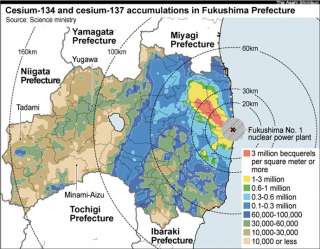
shows over 800 sq km contaminated with accumulated cesium-137 of
600,000 Becquerels or higher per square meter A level of
555,000 Becquerels or higher of cesium-137) that was used to
issue compulsory evacuation orders in the Chernobyl nuclear accident in 1986.
It ought to be noted that there was a US naval ship stationed 2 miles offshore early in the accident and other ships further offshore and this ship was enveloped in a radioactive cloud. The sailors have since suffered devastating health effects and there is a huge lawsuit in progress and some have had children with birth defects. So if they were affected then it is only logical anyone under the plume a few days later when the winds changed direction suffered similarly.
The government put in place regulations on maximum contamination levels in food and drink which were not to exceed a committed effective dose of 5 mSv/year. Farm produce from the Fukushima prefecture was rejected by the rest of the population and this led to problems of relabeling. Within weeks contamination was showing up all over the place and local food manufacturers were performing their own tests. Some of these were detecting plutonium in rice fields up to 50 km away. See here. Given most of the radioactivity from the plant was being carried into the Pacific from water running off the site, this put the entire fisheries at risk. There have been numerous reports of high levels of radioactivity detected in fish. A good example is this one Jan 2013: Fish with radiation over 2,500 times safe levels found near Fukushima plant and another in Oct 2013 about the extremely high levels of nuclear radiation in fish caught in the Pacific: Report raises fresh concerns about radiation levels in Japanese fish And if that is not enough to concern people as reported here in Jan 2012, the Montreal Gazette analyzed the Japanese fisheries data for 22 seafood species that Japan has exported to Canada in recent years. Some cesium was found in 16 of these 22 species in November, the last full month for which data were available. Cesium was especially prevalent in certain of the species: 73 per cent of mackerel tested, 91 per cent of the halibut, 92 per cent of the sardines, 93 per cent of the tuna and eel, 94 per cent of the cod and anchovies and 100 per cent of the carp, seaweed, shark and monkfish.
As the months progressed the government were keen to get the 200,000 or so people back in their homes. They did carryout work to identify areas which were contaminated and then to clean them up and billions of yen were spent in the effort. This consisted of scraping radioactive soil away and dumping it elsewhere which meant they were simply moving around the radioactivity. The clean-up efforts appear to have been a sham and have been criticized for not completing clean-ups, that it was inadequately done and of not disposing of the waste properly. As explained in Box 8, they did the totally ludicrous thing of incinerating some of the radioactive waste which simply had the effect of spreading it much wider. And they still are incinerating it. It would seem the main goal was to be seen to go in and clean-up areas and then declare them safe regardless of whether they were or not.
Unfortunately for the Japanese people far too many of them believe their governments and this will come at great cost to them because thousands returned to their homes even though they shouldn't have. Even worse is that people were consuming food grown in the area and there is almost zero possibility that this is safe. Numerous individuals started taking the own readings using Geiger counters. Immediately after the accident every Geiger counter was bought up and they were soon sold out worldwide. See here. The latest is that the government is trying to encourage people to eat food grown in Fukushima prefecture and they are trying to kick-start this with the food provided in schools. It doesn't get much more cynical and head in the sand than that.
The NRC FOI Documentation
At this point it is necessary to explain about the US NRC documentation. It was mentioned out earlier they had a team on the ground in Japan and they were having daily briefings on the situation and handling the public information side of things in the US. In 2011 Friends of the Earth (FOE), the Nuclear Information and Resource Service (NIRS) and Physicians for Social Responsibility (PSR) as well as Reuters filed Freedom of Information requests to the NRC to try out find out what they knew. See here for coverage of it. The information was eventually provided and as part of the standard technique they released thousands of documents in the hope that the sheer quantity of information would make it hard to find anything useful. See here. It consists mainly of emails and transcripts of telephone conference calls where they are discussing the situation as it unfolded. The participants are clearly aware that what they write and say could eventually come under FOIA requests and at key points they lower their voice so much that the person doing the transcript was unable to determine what they had said. There are also extensive sections of conversations redacted. Few people have the time or resources to wade through them but one person under the pseudo-name Hatrick Penry did and what he concludes is that there was a massive cover-up and he has given it a name, Plume-Gate.But before continuing on, here are just a two small samples from the NRC FOIA documents and giving an insight into how well the PR machine is totally knit together, linking directly with the ambassador in Japan although he is just considered an mouthpiece more than anything. See here for the archive. It is well worth a read. [continues below]
Note: DOE is US Dept of Energy
From: Franovich, Mike
Sent: Tuesday, March 15, 2011 12:06 AM
To: Nieh, Ho
Cc: Warnick, Greg; Warnick, Greg; Kock, Andrea; Zorn, Jason
Subject: Fukushima Daiichi Units Degrading
Hi,
* I called WCO to give him a heads-up and details. The Chairman is in the Ops center on the line with the US Ambassador in Tokyo.
* Unit 2 appears to have gone into a possible reactor vessel breach situation. The fuel was not cooled for hours. The primary containment is likely breached after an explosion near the torus. We may have had an ex-vessel core reaction.
* Unit 4 has a dry spent fuel pool. This unit was in a refueling outage with a hot core offloaded to the pool. It appears a zirconium fire may be in progress.
* DOE has dispatch its rad assessment (RAP) team and will in Japan in seven hours.
* Suggested WCO get with the Chairman to discuss where he may help the Chairman in a divide and conquer approach. The Chairman has no relief where our other operations are being handled by shift/rotation for the ET.
Mike
Sunday, March 13, 2011 -Transcript. Note: The USS Ronald Reagan is an aircraft carrier.
ADMIRAL DONALD: Earlier this evening, as the USS Ronald Reagan was operating off the coast of Japan, we — the ship just arrived. We had given the ship some guidance as far as positioning was concerned to stay clear of the area of the potential plume, basically told her to stay 50 miles outside of the radius of the — 100 miles — excuse me — 50 miles radius outside of the plant — damaged plant — potentially damaged plant, and then 100 miles along the plume with a vector of 45 degrees.
The ship was adhering to that requirement and detected some activity about two and a half times above normal airborne activity using on-board sensors on the aircraft carriers.
So that indicated that they had found the plume and it was probably more significant than what we had originally thought.
The second thing — the second thing that has happened is we have had some helicopters conducting operations from the aircraft carrier and one of the helicopters came back from having stopped on board the Japanese command ship in the area, and people who had been on — were on the helicopter who had walked on the deck of the ship, were monitored and had elevated counts on their feet, 2500 counts per minute.
MR. PONEMAN: Yes, 5,000 d m.
[REDACTED]
But I wanted to get you guys on the line and my expert on the line so we can get the data and then the proper people notified.
MR. PONEMAN: Okay, I have a couple of questions. Number one, in terms of the level of radiation that you are picking up, what’s the delta between that and any information we have from the Japanese or other sources of what the level of radiation would be, given the venting and so forth that we know has occurred?
MR. MUELLER: So — this is Mueller — the sample that was taken and then what we detected, we were 100 nautical miles away and it’s — in our terms it’s — compared to just normal background it’s about 30 times what you would detect just on a normal air sample out at sea.
And so we thought — we thought based on what we had heard on the reactors that we wouldn’t detect that level even at 25 miles. So it’s much greater than what we had thought. We didn’t think we would detect anything at 100 miles.
MR.. PONEMAN: You didn’t think you’d detect anything at 100 miles. Okay, and then in terms of the regulations and so forth of people operating in these kinds of areas, I forget there’s some you know, acronym for it, PAG or something, how do the levels detected compare with what is permissible?
MR. MUELLER: If it were a member of the general public, it would take — well, it would take about 10 hours to reach a limit, a PAG limit.
MR. PONEMAN: Right.
MR. MUELLER: For a member of the general public.
MR. PONEMAN: Right. You mean, at the level you detected?
MR. MUELLER: Yes sir.
MR. PONEMAN: But 10 hours, okay.
MR. MUELLER: Yes sir, and it would be a thyroid dose issue.
MR. PONEMAN: It’s a thyroid dose issue.
Okay, but the net of all this is that the amount of release that is detected by these two episodes or whatever you would call them, is significantly higher than anything you would have expected from what you have been reading from all sources?
MR. MUELLER: Yes sir. The number — the specific number we detected was 2.5 times 10 to the minus nine microcuries per milliliter, airborne, and that’s particulate airborne. It is — we did not take radioiodine samples so I don’t know that value, but this is particulate airborne.
Tell me again exactly how you picked up these two forms of samples.
MR. MUELLER: We have automatic detectors in the plant that picked up — picked up the airborne, and all of our continuous monitors alarmed at the same level, at this value. And then we took portable air samples on the flight desk and got the same value.
ADMIRAL DONALD: These are normally running continuous detectors, continuous monitors that run in the engine room all the time, monitoring our equipment.
MR. PONEMAN: These are detectors on the Reagan?
ADMIRAL DONALD: On the Ronald Reagan, that’s correct.
MR. MUELLER: Yes sir.
MR. PONEMAN: On the Ronald Reagan. They are there because you have got equipment there that,.byou know, it could emit stuff and while you were there, you picked up stuff that was ambient which indicated that you actually were in the plume?
MR. MUELLER: That’s correct.
MR. PONEMAN: And this was — this was 30 times higher than what you would have expected?
MR. MUELLER: Yes sir.
MR. PONEMAN: Okay and the one with the shoes and — tell me about that again.
MR. MUELLER: The shoes were from helicopter crews that flew to a Japanese flag ship that is 50 miles closer to the power plant at sea, so it’s about — it’s about half way so it’s 50 miles from land as well, and it was near the center line of the plume.
And when they flew back to Ronald Reagan, the contamination was found on the shoes of the people that had gotten off and back onto the helo from the Japanese ship.
MR. PONEMAN: And that was also of a level 30 times what you expected or was there a different ratio?
MR. MUELLER: Oh, this is — we use — we have — we would expect nothing and got — it’s about five times our minimum detectable for frisking.
MR. PONEMAN: And what is that measured in?
MR. MUELLER: That’s in — it’s — so it’s about — it’s 10,000 micro-microcuries per 100 square centimeters, or per frisk.
MR. PONEMAN: Does that measure out in something in terms of rems or millirems?
MR. MUELLER: No, that’s — because this is contamination level.
MR. PONEMAN: And 10,000 microcuries per
MR. MUELLER: square centimeters.
MR. PONEMAN: what gets picked up from Ronald Reagan?
MR. PONEMAN: know, the thing that was
MR. MUELLER: Micro-microcuries per 100 And how do you measure the detectors on board the Repeat that again please.
What was the unit — you
– (audio distortion)
It was microcuries per milliliter.
MR. PONEMAN: Right, so it was the same thing you are talking about in terms of the — what you picked up on the Reagan was also measured in microcuries per milliliters.
MR. MUELLER: Yes, one’s a concentration in the air –
MR. PONEMAN: Yes. Yes.
MR. MUELLER: of microcuries per milliliter, and then the other value is on the surface, the surface (inaudible).
MR. PONEMAN: So does Admiral — sorry Minister D’Agostino or others in the DOE chain know about this?
MR. MUELLER: No sir.
MR. PONEMAN: Okay. Well, we better get them apprised. My alarm’s gone off. I got to jump on another call but you are correct. We do need to handle this appropriately. There’s other communications that have been going on and I have got to make sure that this is factored into that.
So I am going to jump off this now but first thing to do would be to brief Administrator D’Agostino because we are going to have to bring him into this as well.
ADMIRAL DONALD: Okay. Yes sir. We can do that.
MR. MUELLER: Right, but this is 100 nautical miles away at 2500 counts per minute. So they don’t even correlate, the two numbers that you just said. It’s a different — it’s much worse if we are detecting 2500 counts per minute on people’s shoes 50 miles away.
MR. WEBER: Yes, but I don’t know where that other vessel was before it was 50 miles off the coast.
MR. MUELLER: That’s true, but with the airborne at — the airborne that we detected at 100 nautical miles, that’s far and above what we would expect.
Box 2: What is Spent Nuclear Fuel and a Zirc Fire?
The fuel for a nuclear reactor comes in the form of nuclear fuel rods containing Uranium pellets which are inserted inside Zirconium rods. Sets of these rods are bundled into fuel assembles, usually between 64 and 100 per assembly. A typical Boiling Water Reactor (BWR) reactor will be loaded with approximately 800 assemblies. When the nuclear fuel (i.e. Uranium) is used up, these assemblies (of rods) are taken out. At this point they are extremely radioactive and physically hot and they are then placed in 'spent fuel pools' which are big concentrate tanks full of water which is used to keep the rods cool. There they stay for several years, decades in practically all cases, until some long term solution is found. The bulk of the heat is lost in the first weeks, months and years and it comes from the heat of radioactive decay. The sheer quantity of radioactivity contained in the assemblies is mind boggling. One estimate puts it at 327 million curies which equates to 12.1 Exa Bq (or 12.1 billion billion Becquerels). Chernobyl is estimated to have released about 11 million curies. Estimates for what has been released already from Fukushima range from twice to 10 times the amount from Chernobyl.
A spent fuel pool must be cooled at all times. If the cooling pumps fail then the water temperature will rise and start to boil. The timing for this depends on how old the rods are. For relatively new rods the pool can boil down in a matter of hours. There is supposed to be several meters of water covering the rods but once the water level drops and starts to expose the top of the rods, the Zirconium cladding will not be able to cool quick enough and it will begin to buckle and in the process the rods split open and release a vast array of radioactive particles and gases. The temperature rises so much that the Zircon will oxidise with water and produce free hydrogen. This is known as a Zircon or 'Zirc' fire. Basically it grabs the oxygen off the water molecule and because ZrO2 is in a much lower energy state, it releases a lot of heat. The result is that all the radioactive material in the fuel rods begins to ablate and thereby releasing huge quantity of radioactive dust and gases. This is an extremely dangerous situation and one of the last things you would ever want to deal with. The radiation surrounding such a fire would be intense and deadly.
| Spent Nuclear Fuel Inventory at Fukushima | ||||||
|---|---|---|---|---|---|---|
| Unit | #1 | #2 | #3 | #4 | #5 | #6 |
| Reactor Fuel Assemblies | 400 | 548 | 548 | 0 | 548 | 764 |
| Spent Fuel Assemblies | 292 | 587 | 514 | 1331 | 946 | 876 |
| Fuel | UO2 | UO2 | MOX | UO2 | UO2 | UO2 |
| New Fuel Assemblies* recently swapped out of reactor |
100 | 28 | 52 | 204 | 48 | 64 |
Overall the documents show that both the NRC and officials in TEPCO and the Japanese government were fully aware of the situation and that meltdowns were in progress. There was unambiguous recognition that coolant was lost and the water was boiling off followed shortly by exposure of the fuel rods. They were also aware of the implications and the type of radionuclides being released. They were running various (computer) models for where the radioactive plumes were going and how they were dispersing and trying to predict the radiation dosage. The story of the spent fuel pools got even less attention than the reactors and yet they contained hundreds of tonnes of deadly radioactive material. Between the earthquake and the explosions which caused massive damage to the reactor buildings one would expect that these storage pools would have been at best damaged if not ruptured and the NRC spend quite a lot of time discussing this for they rightly knew the dangers posed.
Re-consideration of the Damage and Implications
In light of what we know and just by examining photographs of the damage it is worth reconsidering what would be expected from such an outcome. In the first photograph above and the two below (and many others can be found on the web), the extent of the damage is plain to see with three of the reactor buildings shattered, broken pipes strewn around and generally debris all over the site. Given that each of these units contain nuclear reactors and spent fuel pools and three of the units suffered explosions (Unit 1 on March 12th, Unit 2 on March 14th and Unit 3 on March 15th), then it is next to impossible to not recognise that there must have been huge releases of radioactivity.During the accident news reports had said all power had been lost to the site and these lasted for days and this meant that during the accident the continuous cooling required for the spent fuel pools would have been interrupted. There is also a strong likelihood the pools were damaged or cracked and the water drained out, if they had not been already structurally damaged by the massive earthquake earlier on March 11th. Between the three separate units it would have been extraordinary luck if they didn't have a 'zirc fire', which happens when the spent fuel rods are exposed. See box 2 for a description of a zirc fire. The radioactive leak from this would have far exceeded what Chernobyl released. At one point at the height of the emergency it was reported that workers had to abandon the site because of the spike in radiation and elite units of Tokyo Fire Department and Japanese Self-Defense Force used unmanned remote-controlled fire trucks to spray to get in at the plant. There would have been a frantic effort to keep those spent fuel pools cooled and the photograph below shows a long hydraulic pipe of the type used typically for pouring concrete, being used to deliver water into it. And we know from reports they tried for a time to use helicopters to dump water but this was abandoned because the radiation was too intense and they weren't hitting the target. After the first explosion they were still trying to prevent a core meltdown in two of the other reactors. The situation could be best summed up as completely out of control.
What is interesting though is the explosion that got wide video coverage mostly because it was so powerful. It was of unit #3 exploding at 11am on March 15th. This was the one that used MOX fuel containing plutonium. In the first picture below it shows a comparison with the unit #1 explosion which was most likely a hydrogen explosion. The second image is a sequence of 4 video frames of the unit #3 explosion. What is noticeable is the speed at which the explosion develops and the sharp vertical plume indicating a very rapid velocity of ascent. To all intents and purposes it looks like a mini-mushroom cloud. What this would indicate is that there was a 'criticality' event and this means that nuclear reactions have started up again but it is first necessary to describe how and why this occurs.
A Nuclear Criticality Event
In an nuclear fission reaction the emission of neutrons from Uranium and or plutonium will trigger further fissions if they happen to be absorbed by surrounding Uranium / plutonium atoms. Because the nuclei are tiny the chances of this happening are low. However if all the atoms are squeezed tightly together for a moment, then the chance of absorbing a neutron is vastly increased and a rapid chain reaction can occur. The speed of nuclear reactions are extremely rapid and will happen in under a femtosecond or one million billionth of a second. In an atomic bomb where the material is compressed by an initiating explosion, this speed is important because it means there is an exponential surge and release of energy. In the case of a nuclear reactor the rods are held sufficiently close together to keep the nuclear reaction going but are sufficiently far apart to prevent the runaway chain reaction. There is normally extra material present that can be inserted to absorb the neutrons. All of this explains why you cannot store nuclear fuel close together. It has to be separated by a certain minimum distance. In a criticality event what happens is that the fuel has come too close together and in an uncontrolled situation where a big mass of fuel or recently spent fuel rods fall in a heap then the conditions are met for nuclear reactions to restart and a rapid surge of energy being released resulting in a blast. The blast will likely disrupt whatever caused it to shut down the explosion quick enough to prevent it becoming an atomic bomb type of explosion because in such a device it is purposely designed to keep it together for as long as possible thereby allowing the explosion to develop and get even larger.
Unit 3 Explosion
There are two possibilities. 1) The fuel rods were exposed in the reactor because of loss of water and the rods had heated up, buckled and dropped to the floor and an criticality event occured there or 2) the spent fuel rods were exposed because the tank was emptied and there was a zirc fire and the fuel assemblies collapsed and fell on top of each other. In either scenario a blast like the one on the video would have vaporized a large amount of nuclear material and injected into the atmosphere. The surrounding area would have been rained down with pieces of fuel rods and other highly radioactive material and trillions upon trillions of tiny specks of radioactive particles including plutonium.Arnie Gundersen, an American physicist with over 30 years nuclear industry experience discusses the explosion and he points out that it is a detonation supersonic shockwave and the fact there is no nuclear containment in the world can withstand a detonation shockwave. And he comes to the conclusion that the explosion was in the spent fuel pool and was what he calls a prompt moderated criticality occurred in unit 3. He also points out that the radiation is so lethal around it, that the unit #3 spent fuel pool cannot be accessed. The video can be found here. In another separate video from March 29th 2011, he also discusses the news of the discovery of plutonium and highly radioactive water on the site and the fact that this is draining into the ocean. It can be found here and it is worth watching.
Public Reaction and Government Response
All of this would suggest that things are not going well and it is much worse than the bland reassurances we have all received from the mainstream media and our respective politicians and governments. It is the lack of coverage and apparent interest that helps create the notion that there is nothing much to worry about that is newsworthy and therefore it is alright. Given the obvious releases of radioactivity it then begs the question what embargos if any are in place about food from Japan or advice about travelling to Japan because every week there will be many people who travel there for business or as students or even as tourists and they will be taking their cues from the media and any announcements from Japan itself, to determine whether it is safe to go there. After-all Japan won the 2020 Olympics bid. See box 6 for more details. It would be foolish in the extreme to consume any Japanese food and especially fish. Most governments are simply not testing it. That way they find nothing, thereby in the Orwellian logic so prevalent these days, makes it safe. Most people would automatically assume it is being tested.There has been little coverage in the media except to belittle and rubbish the claims by several scientists and critics of the nuclear industry as well as Arnie Gundersen who have said that the Fukushima accident is far worse than Chernobyl in 1986 was and it has released up to 10 times more radioactivity into the environment. Given the scale of damage on the site it would be surprising if this was not so. This information while useful is a little bit late because if people remember back to Chernobyl there was widespread coverage of the fallout and bans and restrictions were put in place as required. For instance in parts of the uplands of Scotland and Wales and even here in Ireland in Wicklow, there were restrictions on the sale of lamb meat which were in effect in some areas for over a decade because of contamination by radioactive cesium. Farmers were compensated to prevent illegal relabeling of the meat and thus prevent contaminated food entering the food chain. In Norway reindeer farmers couldn't sell their meet for years either. The reason it affected these types of areas is because the acidic soil of upland peat and the tundra retains cesium much longer.
The question then is why isn't there the same response today? Part of the answer may have to do with the neo-liberal and corporate takeover of society and consolidation of the media. In the past, people could complain and protest and they might get some response and sometimes a victory or two resulting in some kind of action and back in 1986 governments would have been afraid not to carry out the radioactive measurements and would have felt obliged to protect the public and food chain. Today however in the era of mass surveillance, spin-doctors and PR consultants, and public trust in most institutions has broken down, people are just ignored while billions are given to the rich and at the same time the very social fabric and safety nets of society are being torn asunder, the citizens are largely treated with contempt. It is no wonder then that there has been virtually no response by national governments to the Fukushima accident. What is quite suspect too is that uniformly each State, the majority of which have national radiological bodies for monitoring radiation all report trace amounts of radiation of negligible risk. It seems that they are being economical with the truth and probably carefully crafted their press releases since this is the norm now to distort reality and manage perceptions.
TEPCO's Handling of the Crisis
TEPCO has rightly come into a lot of criticism for it's handling of the crisis and it is easy to see why. It lied about the accident saying it was unforeseen even though they had lobbied not to raise the height of the sea-wall. They were continuously in breach of numerous regulations and had been instructed to carry out repairs and fix things at many of it's sites. It deliberately misled the public and failed to warn them at key times. It was dis-organised and at the height of the crisis it was unable to coordinate and prioritise all the different requests and reports. The list goes on.An example of the farcical levels things had reached on the human side is demonstrated in this transcript [reported here] from tapes released showing how TEPCO handled the accident and it concerned the situation where they couldn’t seem to get their hands on a battery, although we do have to remember the entire coastline region was devastated by the earthquake. 'In fact, it took about 24 hours and trip to the hardware store to buy it while on the brink of meltdown. With reactors 2 and 3 on the verge of having a meltdown, the on-site team had to open a valve to release coolant into the reactors. However, with the extensive damage to the plant, an ordinary car battery was needed to power the valve controls.'
Fukushima Daiichi Materials Team: 'We don’t have enough cash. Sorry to ask but if it’s possible could you lend it to me? We’d appreciate it.”Head Office Akio Komori, Managing Director (at the time): "I wonder if someone’s using the helicopter today. Who’s using the helicopter? We can use a helicopter to carry the cash."
Narrator: "Units 2 and 3 are also in danger of meltdown. They had to connect a car battery to the valve to activate the reactor coolant. However, there wasn’t even enough cash to buy one...Finally after 10 hours..."
Head Office: Akio Komori, Managing Director (at the time): "We sent a person from the head office to [Fukushima’s] off-site center carrying a lot of cash. You can get it from the off-site center."
Fukushima Daiichi: Masao Yoshida, Fukushima Director (at the time): "Okay, I should write an IOU for this, right?"
Head Office: Akio Komori, Managing Director (at the time): 'No need. I’ll take your word for it."
Fukushima Daiichi: Masao Yoshida: "Got it. Thank you."
Narrator: However, instructions to evacuate beyond 20km of Fukushima have already gone out. There were no shops open nearby.
Fukushima Daiichi Materials Team: "We are working hard to procure [a battery] but our best chance is in Iwaki which is 6 hours away. We request your assistance, Head Office."
Off-Site Center: "Today we went to Iwaki to get a battery but couldn’t get one."
Fukushima Daiichi Materials Team: "Tomorrow we’re going to a home center to buy stuff. If there’s anything you want bring us a list or tell us... whatever... just come down."
Narrator: "It’s unbelievable that they would go shopping for supplies at a home center during the worst nuclear disaster in the world."
The report concludes with: 'Soon after both units 2 and 3 were said to have reached meltdown. Yoshida retired late last year, reportedly diagnosed with cancer and having suffered a brain hemorrhage which experts say are not related to radiation exposure'.
Current Official State of Conditions at the Fukushima Daiichi Site
The current offical state of the Fukushima site is that the clean-up is continuing and they are still pouring water into the reactors although it is really onto the melted cores somewhere under the reactors via the holes in the base of them. TEPCO had indicated that about 300 tonnes a day are being used for this. Additionally because the site is on the coast and at the bottom of a hill there is a certain amount of groundwater that naturally passes through the site on it's way to the sea and TEPCO have said this amounts to about 300 tonnes of groundwater passing through the site every day. They have been more circumspect about it being contaminated and the fact it is pouring into the Pacific Ocean every single day.
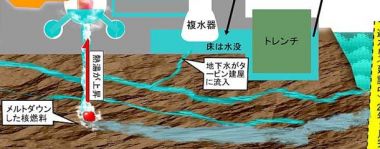
the meltdown cores and flowing into the Pacific ocean.
What TEPCO are trying to do with these tanks is to capture and store the water both flowing through the site and the water which they are using to cool the spent fuel pools and the molten fuel cores that are underground. This is an impossible task and it is being contaminated with highly radioactive particles. The idea is that by pumping the water into the tanks then can later filter the water to extract the radioactive particles. The equipment system known as ALPS to do this breaks down frequently for extended periods, can't remove all substances like Tritium and does not have the capacity to deal with the sheer volume. There is no way that TEPCO can prevent the water that flows through the soil from entering the sea and they have already admitted on many occasions in the past 3 years that indeed there has been discharges of highly radioactive water in the ocean. At one point they had an absurd plan to build an ice wall to try and prevent the water from entering the sea. It is an obviously difficult and impracticable idea.
Towards the end of 2013, they finally admitted indirectly they could not manage this juggling act with the water when after consultation with their US counterparts and government officials that they would start releasing water from the tanks into the ocean. Amazingly they are claiming it will be perfectly safe and have no health effects and their reasoning is that they will filter the water first. But water is already entering the ocean untreated and we are left to simply rely on their assurances it will be safe when they have no credibility although what they do have is the new secrecy laws (see box 6) to keep such information out of the public arena.
Here's another one of many classic reports covering just one of the many leaks.
Tokyo Electric has now admitted that on May 10 2011, at least 250 tons of radioactive liquid leaked into the sea from a pit near the intake at Unit 3, whose fuel was spiked with plutonium. According to the Japanese government, the leak contained about 100 times the annual allowable contamination. About 500 tons leaked from Unit 2 from April 1 to April 6. Other leaks have been steady and virtually impossible to trace.
In light of all this one simple fact should be obvious and that is around 300 tonnes of highly radioactive water has been entering the Pacific Ocean for the last three years. Never before has anything remotely like this happened or for so long. This radioactive waste has to be dispersing throughout the entire Pacific Ocean. And the flipside of this is how long is this going to continue for? The inshore waters though will most affected and any fish, shellfish or other creatures in it or passing through it will be contaminated.
The other remaining problem and there are lots of them, which got a fair amount of press attention in the last six months of 2013 was the fact that the spent fuel pool in the heavily damaged unit #4 building was filled to capacity before the accident, now contains damaged and broken fuel assemblies and these need to be urgently removed. The reason is the fear that the building could heave over because the ground is apparently sinking from all the water. Removing these fuel assemblies is normally done under computer control in a properly functioning plant. If the rods were to come in contact with each other we could end up with a criticality event. There are over 1,300 fuel assemblies in there. (See box 2). To make matters more interesting the radiation level around the pools is about 100 rem. In that environment you would receive a lethal dose in two or three hours. In this video here from Fairewinds Associates by Arnie Gundersen, he discusses the undertaking.
Widespread Contamination in Japan and Pacific Regions
It ought to be obvious by now that there has to be widespread contamination because of the sheer quantity of radioactivity release and because of the three year continual leakage of radioactive waste into the Pacific. There have been many reports that point to this except that nuclear industry shrills have managed to discredit them because they are able to say that no dangerous levels of radiation were detected outside of Japan. This statement in itself is false. The US NRC and EPA were very reluctant to release their figures and even turned off their radiation detection network at one stage. There is even a claim that they intentionally recalibrated the equipment so that it would give lower readings.The first hint that radioactivity was spread far and wide is a research paper published in Nuclear Industry and Health titled: 'An Unexpected Mortality Increase in the United States Follows Arrival of the Radioactive Plume from Fukushima: Is there a Correlation?'. The research paper analysis death figures for 122 US cities and they noticed a small increase in the weeks after Fukushima and come with an estimate of 14,000 additional deaths. The PDF is attached at the end of this article. Interestingly they have this to say about the EPA radiation measurement dataset.
This dataset was much weaker than that reported by the EPA in May-June 1986, in the aftermath of the Chernobyl meltdown. For example, the EPA reported 2,304 milk samples in the United States, with 2,000 (86.8%) reporting a positive number for the three isotopes barium-140, cesium-137, and iodine-131 (6). After Fukushima, there were 670 measurements of milk for 10 isotopes, with just 2.2 percent reporting a positive numerical value (16). Clearly, the 2011 EPA reports cannot be used with confidence for any comprehensive assessment of temporal trends and spatial patterns of U.S. environmental radiation levels originating in Japan.Then in this report from RT on Feb 18th 2013 - Fukushima kids have skyrocketing number of thyroid abnormalities - report says more than 40% of 94,975 children sampled have thyroid abnormalities. They would have got this by exposure from radioactive Iodine. And in the typical fashion of a paid shrill a government-backed researcher claimed there was no health affects. In another article reporting on increased thyroid in newborns on the US West Coast found in research done in the US and published in the Journal of Pediatrics the research papers notes that 'Just days after the meltdowns, I-131 concentrations in US precipitation was measured up to 211 times above normal. Highest levels of I-131 and airborne gross beta were documented in the five US States on the Pacific Ocean.'
Contamination in Tokyo. Soil and Air Samples
In May 2012 Arnie Gundersen posted this report Tokyo Soil Samples Would Be Considered Nuclear Waste In The US on his site about a trip he took to Tokyo in March 2012. While he was there he took five random soils samples from around central downtown Tokyo. He brought these back to the USA and got them analysed by a lab. The results came back and showed they all contained radioactivity material and under safety regulations in the USA the samples themselves would have to be treated as nuclear waste. One sample was from the sidewalk, one from a playground, the side of the road, the roof of a building and from the street. This means that just walking on the streets and parks will transfer radioactivity onto your shoes and shoelaces and this has to be then getting brought indoors. This insidious spread of radioactivity is virtually impossible to stop.In yet another video titled: Hot Particles and Measurement of Radioactivity -Arnie Gundersen Gundersen is discussing radiation measurements with a colleague of radioactive 'hot' particles scooped up by air filters from cars sent from Japan. In the video, Marco Kaltofen points out that it just happens that the amount of air processed by an air filter for the typical mileage done in Japan is approximately the same as processed by the lung of a hard working human and therefore the air filters serve as an excellent proxy to estimate how many hot particles people are inhaling. The image below is an autograph (detects radiation) of the samples and it shows the relative density of hot particles between Fukushima city, Tokyo and Seattle. The lung is really good at capturing particles of a certain size mainly from 0.5 to 5 um (micro-meters) exhaling smaller and larger particles. Thus the size and distribution in any radioactive plume matters. The problem with these hot particles is when they lodge inside your body, for example in your lung. They just sit there continuously emitting radiation, damaging the cells and tissue all around constantly. The image below shows an a lung tissue sample with a hot particle lodged in it and the damage can be seen. Particles in the 10um or smaller range can be easily carried continental distances. They also discuss radiation measurements from children shoes and for all the shoe samples received from Japan they were positive and whatever is on the shoes will get on the hands. Younger people are more sensitive to radiation and developing cancer because their bodies are still growing with lots of cells multiplying.
In this research paper from Biogeosciences the authors discuss Strontium (Sr) releases into the ocean. Strontium behaves chemically like calcium and is taken up in the bones. Radioactive Strontium causes leukaemia because the source of blood cells is in bone marrow where they would gain mutations from exposure to Strontium. In the paper they estimate the amount of radioactive Strontium released into the Pacific based on measurements they had of the waters from 30-600km offshore of Fukushima to be of the order 90 to 900 TBq where TBq is a trillion Becquerels. The exact wording is: Liquid discharges of 90Sr to the ocean were estimated, resulting in an inventory of 53 ± 1 TBq of 90Sr in the inshore study area in June 2011 and total releases of 90Sr ranging from 90 to 900 TBq, depending upon the reported estimates of 137Cs releases that are considered. This is a lot of radioactivity and it is going to be absorbed by algae, plankton, fish, crabs, shellfish and larger predators like tuna, dolphins, seals, sea-otters, sea-birds and including humans who eat any of these contaminated fish.
In line with these discharges and the effects expected, it is unclear how this US government research in Alaska, reported here, got through. In the biological monitoring report it shows a significant cesium isotope signature was detected by Scientists during 2011. A comparison with 1997 sampling show the values to be around 50 times higher on Amchitka and 660 times higher on Adak islands. The 2011 and 1997 tables are extracted from the report and in the image below. Click on to enlarge.
In Jan 2014, it was reported scientists found two conjoined gray whale calves in a Baja California lagoon. It is not possible to attribute the cause but given whales travel widely and eat huge quantities of krill which are low down in the food chain and would be soaking up all that radioactivity, one has to wonder is it a result of exposure to radioactivity in the ocean released by Fukushima. There were also other reports back in Jan 2012 from Alaska where Seals and Walruses Found Dead in Alaska with Mysterious Sores and Hair Loss: Scientists Baffled. These are unusual symptoms especially when found across a number of animals and across species. Perhaps neither of these are caused by Fukushima and are instead due to their body fat being loaded up with toxic industrial chemicals like PCBs, much like in the 1980s, when massive seal deaths in Europeans waters caused by strange diseases was eventually found to be the result of a build up of toxic chemicals that weakened their immune systems leaving them wide open to opportune infections.
Box 3: What is Radioactivity?
There are three main types of radioactivity and each has its own characteristics and the way it can affect you is different. Radioactivity is ultimately caused by instabilities in the nucleus of certain types of atoms often referred to as elements and is the result of these nuclei disintegrating and taking on a new more stable energetic state. The atomic nuclei are composed of protons and neutrons. Because the strong nuclear force is what holds the nuclei of atoms together, any change can result in tremendous energy release when they are re-organised. Generally the heavier an atom the more neutrons you need to have because due to the electrical force the protons are trying to fly apart from each other because they have the same charge, but the strong nuclear force that binds the protons and neutrons together is much stronger and in most cases overcomes this opposing effect. But certain setups and combinations are unstable and this level of instability is related to how radioactive these nuclei are. For example Uranium with a total 235 neutrons and protons (U-235) is more unstable than U-238 even though U-238 is also radioactive but it is far more stable and it is the 3 extra neutrons that give it the stability. (Note: The number of protons essentially defines the type of atom. See the periodic table)Radioactivity is measured in half-lives. So for example Cesium (Cs-137) where it has 55 protons and 82 neutrons, has a half live of 30 years. This means that after 30 years half of all the Cesium atoms in any given collection will have decayed. Then in the next 30 years a further half will have decayed and so on. This means you are dividing by 2 for each half-life period. So if for example you had a pile of radioactive Cesium and it was measuring 64 times higher than the background level, then to work out how many half lives it would take for it to be only 4 times the background level, this is then 64/2 = 32/2 = 16/2 = 8/2 = 4 which is 4 half-lives and in the case of Cesium that means it is 4x30 years or 120 years. So it should be clear you have to treat each particular radioactive material separately and to consider it's half life and do the calculation.
Alpha decay: Alpha decay is when an alpha particle which consists of two protons and neutrons and is thus charged, is emitted from a nucleus. It is basically a bare helium nucleus and within microseconds it will steal electrons from the surrounding environment and eventually become a helium atom. The nucleus left behind will be transformed into a new element. The alpha particle is released at high speed with a huge energy boost and this is measured in energy units known as MeV or millions of electron volts. For most molecular compounds the atoms are bound together with an energy of up to 1 or 2 eV at most and this would be the case for all the biological compounds in your body. When one of these alpha particles is emitted it blasts through any material near the speed of light and rapidly dumps the energy by smashing chemical bonds in it's path and thereby slows down and leaves a trail of very reactive molecules that will in all likelihood react uncontrollably with whatever is around to re-establish their own energy equilibrium. Typically alpha particles can only travel a few centimeters in the body but not before its ripped through the delicate molecular machinery of your cells. An example of alpha decay is when plutonium (Pu-239) alpha decays into Uranium (U-235).
Beta decay: This is when a positively charged electron known as a positron is emitted. It occurs when one of the protons in the nucleus basically dumps its charge (in the form of the positron) and turns into a neutron. As before in this event, the atom is transformed. For example Cesium Cs-134 beta decays to Barium Ba-134 which is a completely different chemical. Again beta rays are charged and travel close to the speed of light on emission but quickly will dump their energy. As it collides with other atoms knocking out (inner) electrons it will give rise to X-rays which in sufficient intensity can be harmful too. In air the beta radiation can travel several meters. Within the body they will do similar damage as alpha decay. For example Krypton (Kr-85) beta decays to Rubidium (Rb-85) with a half life of 10.7 years. Spent nuclear fuel rods contain Kr-85.
Gamma decay: This is a highly energetic photo and essentially lies beyond x-rays. Gamma radiation is highly penetrating and depending on the intensity can penetrate several feet of lead and even more of concrete and you certainly do not want to be in the presence of it.
At any given moment an atomic nucleus is vibrating and it has a certain energy but it can slip out of this mode into another more stable vibrating mode which has a lower energy and when it does this, that difference in energy is converted into the energy of a gamma ray. Gamma rays are of several to tens of MeV in energy. For example Iodine (I-131) gamma decays and this can cause ionization which basically means smashes chemical bonds.
Box 4: Radioactivity Measurements and Effects
There are many measuring units of radioactivity and each have their merits but each have to be qualified by what type of radioactivity it is that is being measured. For example you might want to know the number of (atomic) disintegrations per second (Becquerels) or the intensity of radiation or even the dosage which is a way of trying to quantity the amount of energy received. The units themselves vary enormously and that is because the level of radioactivity does too. Each measuring unit has its metric equivalent. Here is a list of the most commonly referred to measurement units:
Röntgen equivalent man (rem) -measures dosage. Units are 100 erg/ g
Rad (rad) -measures absorbed dose. Units are 100 erg/ g
Becquerel (Bq) -measures activity. Units are decays per second.
Curie (Ci) -measures activity. Units are 3.7 x 1010 decays per second.
One curie is roughly the activity of 1 gram of the radium isotope 226Ra. And since one Becquerel (Bq) is one decay per second then 1 Ci = 3.7 × 1010 Bq = 37 GBq -that is 37 billion decays per second
One sievert equals 100 rem. The rem is an older, non-SI unit of measurement.
There is no one measurement that explains all. For example if a radioactive plume was passing over you the level of radiation might give a certain reading that doesn't seem particularly high or deadly but the plume itself would very likely also contain an aerosol of radioactive particles. If you happen to absorb onto your skin and inhale these microscopic particles and they become lodged inside you, then it is a completely different matter and far more dangerous. This is because for alpha and beta decay you will be largely unprotected and be getting maximum damage for every radioactive atomic nucleus disintegration.
Another factor to consider is the type of radioactive particle. Is it Iodine or Strontium or something else? In the case of Iodine your body will automatically try to concentrate it in your thyroid gland whereas chemically Cesium behaves more like Calcium and will be absorbed into your bones, potentially setting you up for bone cancer. In the case of plutonium (Pu) the body thinks it is iron and will concentrate it in the liver, bone marrow and iron is used for production of sperm, hence you could get cancer of the liver, bone marrow or testicles. Cesium will be attracted to the muscles and organs.
Ingesting radioactive 'hot particles' is categorically different than being exposed to a single exposure of gamma radiation. Particles trapped within the body can behave differently depending upon where they end up. Some radioactive elements collect in the thyroid, as with Iodine-131. Others, such as cesium-137 and 134 collect in muscle tissue and other organs. Strontium-90 collects in bones, and there it stays irradiating the host for likely the remainder of his life. In such close proximity to other cells a radioactive hot particle engages in "cellular disruption (CDC, Cesium 2, Relevance to Public Health)." These radioactive isotopes bombard the nuclei of surrounding cells with energy, and this energy can cause mutations in DNA, thus sparking cancer.
Evidence of Plumes and Models and Plume Gate
It should be clear if the plume had spread over the Tokyo metropolitan with a population of 35 million people, there would be no evacuation because you simply cannot move even a fraction of that many people and there wouldn't be anywhere that they could go and be easily accommodated and besides the mad rush and disruption would cause panic and the image of that would not go down well. Quite simply the only alternative would be to deny it was happening. This would be just as true for any other city in the path of a radioactive plume. For example if a serious accident occurred in Sellafield and they had a zirc fire in one of their many spent fuel pools and we were unfortunate enough to have a North Easterly wind -which is unlikely -blowing over the Dublin, the same logic would be faced by the Irish government.And now back to the NRC FOIA documents. Without going directly to them, one should realize in any situation like this, central to any crisis management in an accident on the scale of Fukushima, would be to have at hand the Meteorlogical Services and one or more teams already proficient at modelling plumes using the latest weather data and forecasting the track of any plume using the latest forecast and weather observations. What the NRC documents unsurprisingly show is that they were doing just that and they were discussing readings taken on board the numerous naval vessels that the USA has stationed off Japan. Normally what is done is you try to get a number of different groups using their own computer models to forecast where the plumes are and if they all agree then that increases the confidence you can have. The problem was that we didn't see these plume models on the nightly news. If we go back to the original news coverage, the general impression given is that the plumes went out to sea and dispersed and weren't the Japanese very fortunate and that was largely it and perhaps a few harmless trace amounts were detected elsewhere.
It was mentioned earlier in the section 'The NRC FOI Documentation' above that a 'Hatrick Penry' did a huge amount of work going through thousands of the NRC documents and uncovered quite a lot of interesting things. He also covered other external material related to the accident. As a result he came to the conclusion that there was a massive cover-up mainly of the extent of the radioactive plumes both in Japan and globally and he put all this work together in a 445 page PDF document which he called Plume Gate and it is available at the end of this article for download. The document contains parts of the transcripts and emails from the NRC exchanged in the days after the accident and most importantly he has dug out some of the charts for the plume model runs and forecasts and three of them are included below.
The first image covers forecasts for March 20th to 23rd 2011 for total deposition off Iodine-131 from the Japanese Meteorlogical Agency. While these are estimates, they would be using weather observations on wind and precipitation at the time to work out where plume would disperse and it is quite clear Tokyo and other cities and large parts of Japan are affected. The second image is from Obninisk Russian Meteorlogical Service who have expertise in modelling and the NRC were using the outputs from this. Their model run simulates the relative dispersion of a certain release of radioactivity for the same dates and it matches quite well with the first model. The text on the first image points out that while the release of Plutonium was not modelled and probably for fear the data would eventually get released, there would be little difference in the fallout pattern. This ties in nicely with the radioactivity detected by Arnie Gundersen in Tokyo and the sets of car air filters that were analyzed and showed up the presence of hot particles. There are probably many readings taken by concerned Japanese citizens (e.g www.SafeCast.org) and whilst there would be a lot of variability due to the limitations of Geiger counters and calibration issues, a random check of the Internet shows many reports of the presence of contamination.The next image below is another model run from the Japanese Meteorological Agency and it covers the 16th to 21st March 2011 over a wider area over the Pacific basin. What is shows is that the radioactive cloud is dispersed over a broad area but it also more or less follows the direction of the Polar Jetstream which is exactly what would be expected. It should be borne in mind that the NRC only ran computer models of the plume for a limited number of days but emissions from Fukushima would have continued for weeks if not on and off for months into the atmosphere and continuously to the present day into the ocean. The relatively high readings detected on the Islands of Amchitka and Adak islands (described earlier) which are in the Aleutian island chain off Alaska are right on the path of the plume. The reports cited earlier about seals and walruses found dead in Alaska with mysterious sores and hair loss so far officially are not said to be caused by exposure to radiation, there are two things to consider. The first is that the Jet Stream has clearly carried alot of hot particles into that region and discharges into the Pacific would have also brought contamination which although much more diluted could be rapidly concentrated up the food chain to top predators like seals and walruses. And two if an attempt has been made to cover this up, then the NRC working with the Dept of Energy would have full authority over any release of government information when it concerns radioactivity and most certainly would not disclose this if they felt it was a 'national security' issue which must be one of the most misused and abused privileges used by governments everywhere. They would then be easily able to rubbish any claims suggesting otherwise since the data would not be available. Unfortunately because there is so little trust and government have a long and very broad record of abusing trust and lying, then it is not surprising that people do jump to conclusions and it becomes extremely difficult to work out what is the case. But the justification works on the principle summed up by George W. Bush
"You can fool some of the people all the time, and those are the ones you want to concentrate on."
Box 5: Radiation and Health - Radiation doesn't just mean cancer
Radiation and cancer are synonymous to the point where we only think of nuclear radiation causing cancer but exposure to radioactivity causes a host of other health problems too. This should not be surprising because radiation blasts away at cells in the body including the DNA. In the case of DNA damage especially to sperm and eggs, it can have devastating effects on a developing embryo resulting in horrible birth defects. What is not commonly realized is that not all the DNA is expressed or activated because there can be multiple copies of genes or certain genes may be switched off and this can be significant. In genetic biology it is widely recognised that there can be as much variation within the genome of a single individual as amongst a population but we don't see it because most the variation is not expressed. This partially explains why populations can crash to quite low numbers and still recover. The flip-side in terms of exposure to radioactive contamination is that the sperm, eggs and or foetus may have been exposed and resulted in the birth of what appears like a healthy individual but within that person the DNA has been damaged but in genes not expressed currently. However when that person goes onto to have children the damage will be passed down and it can take up to 20 generations for the damage to manifest itself. This was discovered to be the case in many biological studies with creatures that have short lifespans. In the case of atomic bomb survivors, these effects are arising in their grandchildren.Incidentally the widespread use of Depleted Uranium which uses U-238 for armour piercing weapons in the forms of missiles, anti-tank weapons and high calibre bullets during the Gulf War II in Iraq where over 4,000 tonnes of depleted Uranium was used has resulted in the release of a fine aerosol of microscope radioactive particles on impact as these weapons vaporise on explosive impact. As this fine dust has settled down, it has been inhaled by locals and animals alike, contaminated the soil and water tables. This has caused a huge surge in horrifying birth defects and widespread cancers which were previously extremely rare. The net effect is that the collective genetic genome of the peoples of the Middle East is being irreversibly destroyed for all future generations. These weapons were and are used in Afghanistan with the same horrific results and widespread contamination of aquifers. The use of such weapons of this nature even by the 1950s was recognised and they were classed as weapons of mass destruction back then.
The other types of damage to your health arise because the radiation damages the cells of each of the organs such that significant quantities of them fail or operate incorrectly or only partially. This applies to all your organs and your immune system too. Ever since the Chernobyl accident in 1986 the term Chernobyl heart has become known and it is caused by general deterioration of the heart cells as radionuclides accumulate and damage tissue killing and weakening cells. This impacts poorly on the heart. There is also another condition known as Chernobyl AIDS and this is where the immune system is so damaged it no longer works at full capacity and the person gets all types of chronic infections weakening them, giving rise to fatigue and lethargy and eventually death.
Yet another condition covering a broad range of effects is known as Chronic Radiation Syndrome (CRS) first secretly documented in 1950 by Soviet doctors. It affected the residents of in the village of Muslumovo and surrounds in the southern Russian Urals where back in 1949 high level radioactive waste at a plutonium plant was released in the Techa river contaminating a large area. CRS is caused by extended exposure to low doses of radioactive elements. Workers at the plant started out headaches, sharp pains in bones and joints, and constant weariness. In the declassified records one entry describes the terrible ache of CRS as a pain that made him 'want to crawl up the walls.' They lost weight. Their gait slowed. They suffered severe anemia, wheezed heavily, and started to show signs of heart disease. The doctors learned to predict the onset of this mysterious new illness by changes in the blood, often signalled in severe anemia.
By 1999, 95% of the children born in Muslumovo had genetic disorders and 90% of them suffered from anemia, fatigue, or immune disorders.
One will notice that these other health aspects are never discussed in the mainstream media on any sort of regular basis and this is clearly because by keeping the lid on it, it prevents people from understanding more about the dangers and the consequences. The original association with cancer would have been unavoidable to hide although since Fukushima there have been several spineless shrills who have even tried to claim radiation is safe. Thus rollback of hard won public knowledge is always something that the system tries to do.
Amongst the more known ones are birth defects. It causes a lot of other health problems too.
See Chernobyl Heart (2004) http://www.youtube.com/watch?v=8ujAG_Ofj4M
There were other organisations doing computer models of the Fukushima plume. For example one was the Norwegian Air Institute and they carried out plume dispersion modelling during the weeks after the accident. The image below is one example of output from them and it is for May 9th to 12th 2011 and what is significant is that it is modelling a release of Iodine-131 (half-life 8 days) almost two months after the initial accident and strongly suggests that fission reactions were still occuring somewhere for example in the molten coriums or spent nuclear fuel rods were exposed and releasing their contents which would consist of a wide range of fission products, one of which includes Iodine.
Another set of models were run by the Centre for Education and Research in the Environment and Atmosphere (CEREA) at joint laboratory École des Ponts ParisTech and EdF R&D. The two model runs shown are of cesium dispersion with a snapshot for 21st and 29th of March 2011. It should be evident by now that given explosions and the meltdowns there were multiple plumes and these spread out across the Pacific and entire North Hemisphere and when this is contrasted with the reaction of authorities after Chernobyl compared to now, it is a bit strange the lack of reported detections of radioactivity from Fukushima. But to complete this picture a bit, it is worth including the text of a report about a 18 day Chinese scientific cruise off the waters of Japan in June/July 2011 that took water samples. The air samples are normal because at that time the plumes would have dispersed.
And here is another example of how when the risk of someone going off base and analyzing this stuff the team swings into high gear and involves the highest levels of government to ensure there is only one message gets out.
Beijing, Jul 31 (PTI) Waters of the western Pacific, close to Japan's tsunami-hit nuclear plant, are "clearly affected" by the radioactive materials leaked from the crippled Fukushima facility, tests by China's state agency have found.China's State Oceanic Administration, which conducted the studies in the area, said today that waters in the western Pacific region, close to the east and southeast of the Fukushima nuclear power plant are found to have radioactive material in excess of normal quantities.
Initial tests of samples collected from these areas show that radioactive Cesium-137 and -134, as well as Strontium-90 can be found in all water samples, it said in a statement.
Under normal conditions, Cesium-134 cannot be detected in sea waters, but the maximum amounts of Cesium-137 and Strontium-90 detected in the samples are 300 times and 10 times, respectively, of the amounts of natural background radiation in China's territorial waters, it said.
The administration has sent professional personnel to these waters to monitor the impact of the crisis at the Fukushima Daiichi nuclear power plant, as well as to China”s territorial waters.
The 18-day voyage, which ended on July 4, monitored waters of 25.2 square kilometers stretch, and the monitoring team collected air, water and biological samples from the spot areas, the statement said. The administration will continue to publish results of further testing and evaluations of the samples, the statement said.
Source here and here
This is a transcript of an audio file from March 12th 2011. National Labs would refer to the US nuclear weapons national labs who have huge expertise and resources in all things nuclear.MR. SHARON: This is Brian Sharon. Quick question, well, not question, but I’ve gotten a couple of emails here today, from some of the National Labs, and they’re all - there are a couple of them chomping a the bit, you know, saying, "Ghee, can we help? Ghee, can we go calculate this," with the codes and all that stuff.
I keep telling them, "No, you don’t know the scenario," but you know, somebody might want to call DOE and tell them to tell their labs to cool it, because the last thing we want is the labs going off, talking to the press, talking about consequences and all sorts of other stuff, because you know, they’re chomping at the bit, to do something, and I’m not sure, Eliot, maybe you’ve got a point of contact up there at DOE?
MR. BRENNER: I’ll send a note to their Press Secretary, asking him, through his chain, to reach out, down to the labs and tell them to back off. If we’ve got other chains, we might as well -
MALE PARTICIPANT: If I could chime in on that? On the Deputy’s call yesterday, I was on with the Chairman, and Pete Lyons was one of the principals at DOE. Lyons may be a good source to contact at DOE.
MR. JOHNSON: This is Mike Johnson. My other thought was, it may be just to cut to the chase, just to pass the same, to call the lab directors and say, "Knock it off," or whatever messages we want to get to them.
There are a number of ways we can do this.
So, I agree, Brian, we’ve got to do it soon.
MR. McDERMOTT: Okay, we’ll take that action from headquarters.
Conclusion
In summary then it is likely we will never find out what the full extent of the contamination is and even though a certain amount was revealed by the NRC documents, there are significant and important parts which are redacted and there is simply no way that anything that shows the true extent will ever be permitted to be released by whatever means. We should also bear in mind in light of the NSA leaks by Edward Snowden which amongst other things revealed the very extensive, sophisticated and active offense cyber attack capabilities, then anything that does appear on the Internet will be hacked in short order and removed.At the accident site itself, the problems are so large and too large for a company like TEPCO according to Gundersen, and the complexity of the tasks is so great that the cleanup is going to be still going on 50 years if not 100 years from now. However there is one problem with this, as the global industrial civilisation slides down the back of Peak Oil now that we are already past the cheap energy era, it will be virtually impossible to maintain the infrastructure of our energy intensive and complex infrastructure and this will be just as true for Japan. It is hard to see how there will be enough wealth left in the system to train a new army of nuclear engineers and pay dead money on cleaning up a mess that has long since ceased contributing any benefits -in the form of electricity - to society.
What makes matters worse is that Japanese culture or society is not good at collectively admitting there are problems and all the evidence is that the entire body politic is in denial and would sooner brush it all under the carpet. This can only make matters worse and prolong the pain. For instance unlike Germany, Japan has never in any public way to its own people ever owned up to its role in the Second World War and the atrocities they carried out in China and before the War. And so it seems in their completely stupid and reckless at incinerating radioactive waste is just another example of this type of behaviour.
What we see with the Fukushima accident is the future. There are approximately 450 nuclear reactors around the world, many are 30 or even 40 years old. Just recently a spate of leaks from spent fuel ponds and storage tanks have been reported throughout the USA and this is a symptom of the age of these tanks and they are all beginning to develop faults and fail and since they were built in broadly the same decade, their meantime to failure will be at much the same time too. Over the next few decades we can expect to see more Fukushimas. If you are willing to spend the time and dig a little what you will find is a long catalogue of serious problems at nuclear facilities all over the world, each one capable of causing it's own disaster. It was the era of high growth and availability of plentiful cheap energy that allowed the initial surge and provided the wealth to enable all these plants to be built. This wealth has been replaced by a massive global debt bubble and governments simply don't have the money to look after them and carefully manage their controlled decommissioning. The predatory capitalist system has little interest in mere matters of safety for the bottom line is the only concern. They rightly know that they can run these nuclear plants at a profit because many of them are already operating beyond their original lifespan and the capital has been paid off, so what they are getting now is mainly profit. If a plant fails, they can walk away and hand the problem over to the government. In most countries with nuclear energy, it is written into national law, that the government picks up the tab after the first few hundred million for any consequences of a serious accident. See for instance the Price-Anderson Nuclear Industries Indemnity Act. You can be sure that Japanese government will be on the hook for the cleanup TEPCO is carrying out. The question then is how many of these nuclear plants going to have accidents. The answer is probably quite a lot and the more it happens and the more experienced the nuclear industry and governments get at making it a non-issue, the more frequently it will occur. What we do know is this. The nuclear industry won't get cleaner or safer until real public pressure forces it and the cleanups will be more tokenistic PR efforts until people force it to be otherwise. The democratic deficit just like it had a major role to play in the financial crisis is thus an important factor in the unfolding disaster that is nuclear power.
So what are the options? The first one would be to skip the 2020 Olympics, do not consume any Japanese food including fish. Avoid any travel there unless you absolutely have to. The second step would be to find out more and educate yourself, perhaps even join a citizen network for radiation measurements and find out what your area is like. Third, find out what foods are good at removing certain chemicals, because if you live in a contaminated area or have been affected, certain foods are good at removing certain compounds from the body. And fourth, stop being ignorant because it could cost you your health.
Box 6: Some of the Cover-up Techniques by TEPCO and Japanese Government
The Chernobyl accident thought the authorities a lot in handling nuclear accidents but the lesson was not really in the actual reactor itself but more on the control of information. In Chernobyl the Soviet authorities immediately made a decree raising the safe limit of radiation exposure to a much higher level. There was another secret decree that all hospitals keep two sets of books. One were the real data and the other would be what was released to the public. So the official picture gave the impression of only a very mild effect.
When the Fukushima accident happened the Japanese authorities showed they had learned the lessons. First they denied the severity of the accident for months and in within a few weeks in April they announced the 'safe' level of exposure for children was to be raised from one to 20 millisieverts per year. This is a level that leads to 2,270 cancers annually per million people (or 160,000 lifetime cancers per million), according to data in a landmark 2006 U.S. National Academy of Sciences report on radiation cancer risk. The beauty of this move is that it meant huge areas of contamination previously deemed unsafe were now 'safe'. Other tricks and these were used continuously was to under report radiation levels. They declared contaminated areas and told residents they were safe to return when they weren't.
In Nov 2011 TEPCO announced they had reached cold-shutdown. This was another lie. It gave the pretence that they had somehow shutdown the reactors in a controlled manner. It was part of the PR for their international image. There was no shutdown because three of the reactors had core meltdowns and the molten nuclear slag was slowly working its way down through the soil. All it meant was that the temperature of the reactors had fallen below 100 C and they had stopped pouring cooling water into the now empty reactors. See further commentary from the science journal, Nature.
And in Sept 2013 they took this to the logical extreme by bidding for the 2020 Olympics and actually won the bid. The whole affair was an exercise in propaganda to put out the image that Japan was safe and will be safe. It has to rate as one of the most cynical and dishonest acts by the Abe' government. To quote the arrogant lies from Abe to the press at the time. 'Let me assure you the situation is under control...It has never done and will never do any damage to Tokyo...There are no health-related problems until now, and nor will there be in the future - I make the statement to you in the most emphatic and unequivocal way.' If anyone is reassured by this, they would want to get their head examined.
This was followed later in 2013 a new secrecy law Designated Secrets Bill, was rammed through parliament. The law allows the government to declare any information it likes as "state secrets" with very severe punishments. The law has no checks and balances and is wide open to abuse and will completely muzzle the press. Part of the hysteria created by the Japanese government was to remove bad 'rumours' about Fukushima. The supposedly free democratic nation of Japan, which supposedly values and promotes freedom of speech, has officially issued orders to telecommunication companies and webmasters to remove content from websites that counter the official government position that the disaster is over and there is no more threat from the radiation. They have also passed an order allows police unrestricted access to monitor all Internet communications to crack down on the 'rumors'. And in the spirit of the neo-liberal merger of corporate and state power, Japan has issued open bids for companies to monitor blogs and social media such as tweets to crack down on the information making its way around the internet.
See more here and here -Japan Passes Law To Cleanse Internet Of "Bad" Fukushima Radiation News [Tangentially, the PM Mori has declared that subjects of intense public debate, such as the Trans-Pacific Partnership (TPP) economic agreement (free trade agreement) currently being negotiated behind closed doors with the United States and other countries, could be designated as secrets. The TPP is an treaty for multinational corporations that will remove all the last vestiges of sovereignty and national regulation and rights. If signed for the Pacific region then it will be pushed for Atlantic region -i.e. US & EU.]
Finally see also: Former Japan Ambassador: US gov’t is main reason why crisis at Fukushima Unit 4 has been "toned down" (VIDEO)
Box 7: Citizens fight back by creating their own radiation measurement networks.
http://www.radiationnetwork.com/ and www.SafeCast.orgIn theory governments represent the culmination of cooperation of people living in a society and it is supposed to represent the division of labour and expertise to look after, protect and help the people. As with all complex systems it is open to exploitation and the parasitic behaviour of the elite who happen to be the rich ultimately have co-opted the machinery of the state to serve their needs rather than the majority of the people. Complex systems evolve and so have governments but much of this has been under the direction of the parasites who have ensured it has changed structurally so that it is harder and harder for the host (i.e. the people) to fight back and redirect the functioning of the state back to its needs.
What all this means is that every Western country is under the direction of the capitalist class and the last thing they want is panic and people objecting and even worse opposing nuclear power or indeed any other project that they have. As a result governments have in some cases simply switched off their radiation detectors in some places and as policy do not let the public see the raw data measurements. They outright refuse to sample and test food for radioactive contamination and even when they do release measurements they always fall on the side of whatever the safe limit is or else whatever peak was measured was of very short duration and extremely safe. But people are noticing a pattern here and trust is breaking down considering governments have a long track record of dishonesty and outright lies over a vast spectrum of subject matter.
As a result people are having to go back to basics. They are forming their own ad-hoc networks and by cooperating together and pooling the talents, knowledge and resources, they are attempting to build their own independent networks. One such network for radiation measurements is RADNet. This is composed of individuals making measurements mostly with Geiger counters and pooling their results on a website. As time progress, this system is evolving and they are improving their techniques. Regrettably they don't have anything remotely like the resources they should have and which the state has but they are making a difference. These types of networks are very effective because they are good at harnessing the power of thousands of people and save on the infrastructure setup of a measuring network because with enough people then by virtue of the random places they report from, you get widespread (measurement) coverage. It's a bit like science done by thousands of people together simultaneously for the same study. What RADnet has shown is that radiation levels go up and down quite a lot, it is varied and the level of overall exposure is far higher than what official governments figure say.
Unfortunately this network and other ones like it will come under attack from the state as the intelligence state (aka NSA, GCHQ or whatever is in your country) will seek to undermine, infiltrate, damage, sabotage, disrupt and undermine the people and their websites and equipment in these networks. Indeed it is highly likely they will label this as terrorist activity and with tongue in cheek one could suppose it is because it terrorizes the elite that people can slip out from under their totalitarian control and report the actual truth for a short while before they close down their websites and remove all trace of the information from the Internet.
Box 8: Fukushima Accident Cleanup.
So far the cleanup of the accident can be summed up in one word -Denial. This has been the approach of TEPCO and the Japanese government from the start. They have denied the extent of the massive problem and tried to sweep the problem away. They even classified the accident as level 4 on the International Nuclear and Radiological Event Scale (INES) when it was level 7 from the start. The latest incarnation of this was when they brought in a dangerous new law making all information about Fukushima and the nuclear industry highly classified and thereby making it illegal to say anything about the accident and with hefty prisons sentences for those who are deemed to break it. This has had the desired effect with an almost complete shutdown on information coming from the press in Japan about the progress of the cleanup.
Within months it seems the Japanese set out intentionally to ruin any chance of monitoring the health effects long term of the accident. One would imagine that in the decades ahead the most tragic effects will in general show up in populations nearer the plant. To sabotage this natural effect the Japanese government ordered that the waste (including soil) cleaned up in the thousands of identified radioactive hot-spots be incinerated. This had the effect of simply dispersing the nuclear contamination even further far and wide. The effect of this is to spread the contamination more evenly over the whole country. This will then allow the government and nuclear industry to claim that any health effects are NOT due to the nuclear accident because they will appear more evenly over the entire country and they will argue it must be for some other reason because they will say you would expect the worst effects to be located in the region around Fukushima. [Incineration is a chemical reaction and has absolutely no effect on the radioactivity of a substance. Any secondary school child learning basic science should know that.]
![]() plumegate_hatrickpenry.pdf
28.98 Mb
plumegate_hatrickpenry.pdf
28.98 Mb
